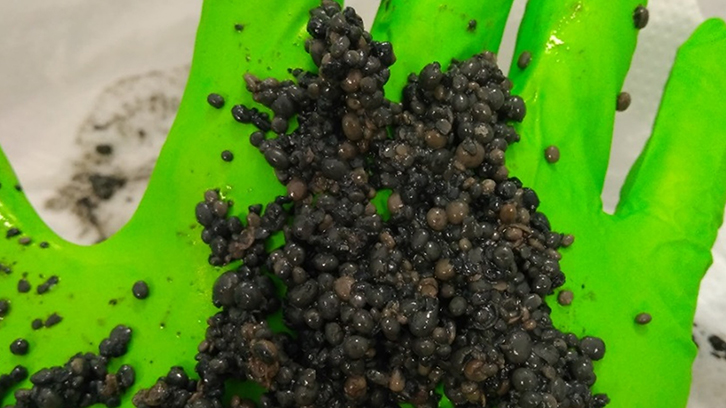Sulfidogenesis from crude glycerol: the first step towards the production of biological elemental sulfur from S-laden effluents

It is interesting to study sulfate-reducing organisms in biotechnological processes, in which these reduce sulfates and produce sulfides with crude glycerol, for example. However, is complex to get to this point, due to the toxicity of the resulting sulfide and the struggle with methanogenic organisms that use glycerol derivatives to produce biogas. The goal of the present research is to manufacture elemental sulfur efficiently with this sulfide in a second stage of production. To do so, it is necessary to evaluate the dynamics of crude glycerol inside the biological reactor, where sulfide is manufactured, taking into account the conditions to which it is subjected.
Sulfidogenesis is the process that generates sulfide and/or hydrogen sulfide as a product, which is a toxic and corrosive compound that smells like rotten eggs and is lethal at concentrations above 500 ppmv. Sulfidogenesis occurs in nature chemically and biologically. Some organisms have the ability, in the absence of oxygen (anoxic and/or anaerobic conditions), to reduce sulfur-containing compounds to their reduced form, commonly hydrogen sulfide (H2S(g), H2S(I), HS- o S2-, depending on phase and pH). These organisms, which use both inorganic and organic carbon sources to grow, are called sulfate-reducers, and their role in various biotechnological processes is being studied in the Research Group GENOCOV (UAB).
Specifically, within the framework of the SONOVA project, different strategies for sulfur production in anaerobic reactors (at neutral pH and T of 35 ºC) have been studied, using crude glycerol as an organic source of carbon and energy, which is a residual by-product from the biodiesel industry and it has been treated up to now as waste or has been valorized as biogas. The SONOVA project consists of several stages, but perhaps the most complicated is the sulfidogenesis from crude glycerol, as it is a process that has not been widely studied and therefore requires further research to be implemented at larger scales. The final goal of the project is to generate a value-added product, such as elemental sulfur, from waste effluents rich in sulfur-oxidized compounds (such as sulfites and sulfates). It should be noted that elemental sulfur is a scarce element, which is currently largely extracted from non-renewable sources of energy (oil) and has multiple applications in industry (manufacturing of pigments, polymers, batteries, etc.).
As mentioned above, the performance of sulfidogenesis using crude glycerol is complex, not only because of the toxic and corrosive nature of sulfide, but also because there is an additional biological competition for the organic source by sulfate-reducers and methanogens. The latter organisms, under anaerobic conditions, produce biogas from organic matter, an energy-rich gas mainly consisting of CO2 and methane. Therefore, both populations (sulfate-reducers and methanogens) will find themselves competing for the products derived from the degradation of crude glycerol. For these reasons, it is essential to study the performance of biological reactors under different operating conditions.
In this case, GENOCOV researchers have conducted a set of experiments that have provided information about sulfidogenesis and will allow optimizing the process in a near future. The study of the bioreactor performance under a sequential increase of the inlet crude glycerol concentration or pH shocks is part of the research performed with sulfidogenic bioreactors at GENOCOV. It has been initially observed that increasing the concentration of crude glycerol leads to an enhancement of the sulfate reduction capacities, obtaining triplicated sulfide productivities in the bioreactor (110mg S L-1 h-1).
Additionally, it has been observed that the activity of methanogenic organisms ceases at high concentrations of sulfide, thus gaining the competition over those organisms of interest (sulfate-reducers), but affecting negatively the structure of the biological bed in the bioreactor and, as a consequence, its efficiency. It has also been found that an accidental shock from pH 8.5 to a pH above 11.0 for more than 12 h causes a loss of biological activity and irreversible problems in the bioreactor functionality, with volatile fatty acids accumulation throughout the biological bed. Finally, the genera Desulfovibrio spp., Clostridiales and Desulfobulbus spp. have been identified as the most resistant to this type of operational accidents.
David Gabriel Buguña, Mabel Mora and Francisco Javier Lafuente
Research group GENOCOV, Department of Chemical, Biological and Environmental Engineering. Engineering School, Universitat Autònoma de Barcelona (UAB).
References
Mora, M., Lafuente, J., & Gabriel, D. (2020). Influence of crude glycerol load and pH shocks on the granulation and microbial diversity of a sulfidogenic Upflow Anaerobic Sludge Blanket reactor. Process Safety and Environmental Protection,133, 159-168. https://doi.org/10.1016/j.psep.2019.11.005


